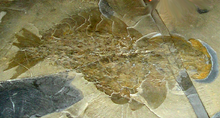奇虾
奇虾是一种于美国、加拿大、波兰、澳洲及中国的寒武纪沉积岩均有发现的古生物,属于奇虾科的奇虾属(属名:Anomalocaris,意为“古怪的虾(Abnormal shrimp)”),是节肢动物门的基群(曾经被划入叶足动物门下)。英国古生物学家约瑟夫·弗雷德里克·怀特韦斯首次发现奇虾化石,查尔斯·都利特·沃尔科特则在伯吉斯页岩考察到更多它们的化石[1]。哈里·B·惠廷顿与德里克·布里吉斯于1985年的《科学》中将许多奇虾的化石碎片误认为不同的物种[1][2]。
| 奇虾属 化石时期:寒武纪早至中期
| |
|---|---|

| |
| 奇虾化石 | |
| 科学分类 | |
| 界: | 动物界 Animalia |
| 门: | 节肢动物门 Arthropoda |
| 纲: | †恐虾纲 Dinocaridida |
| 目: | †放射齿目 Radiodonta |
| 科: | †奇虾科 Anomalocarididae |
| 属: | †奇虾属 Anomalocaris Whiteaves, 1892 |
| 物种 | |
| |
特征
编辑奇虾是一种扁平、具有体节结构的海洋动物,包含前附肢的体长可达70厘米(28英寸)[1],可以使用身体两侧的柔软附肢在水中作波浪状移动[3],附肢在身体的两侧重叠在一起,形成单一的“扇片”来帮助身体在水中移动[3] 。身体最宽的地方位于第三与第五对附肢之间,越往尾部接近就越窄[4],并且至少拥有11对附肢[4]。越接近尾端的附肢很难分辨,所以附肢的数量难以计算[4]。奇虾具有一对很大的眼睛(复眼),估计有多达16,000个水晶体[5][6]。
奇虾口部前具有两个状似虾尾部的附肢,张开可达七英尺[7]。奇虾口锥结构非常独特,为32个重叠的牙板所构成,包括3个大牙板与32个小牙板[1],形似菠萝切片,中央长有一圈坚硬尖锐的牙齿。比起圆形,其口部更像是三放射的,另外那一环牙齿并不能够互相接触到。并且,奇虾的口锥更多是通过负压来吸食猎物,而不是通过噬咬。奇虾具有一个大型的尾扇,可以随着附肢作波浪状运动,很可能可以推动奇虾在水中前进,并加速奇虾转弯[1][3][8] 。
发现
编辑因为矿化作用的缘故,加上古生物学家不清楚奇虾的身体结构,奇虾曾多次被误会。古生物学家认为奇虾的嘴部与附肢比柔软身体更硬,更容易成为化石。约瑟夫·弗雷德里克·怀特韦斯于1892年根据断裂的附肢化石将奇虾视为一种甲壳亚门生物,因为它的外表类似龙虾或虾的尾部。查尔斯·都利特·沃尔科特首次发现奇虾的嘴部化石,并误以为它是水母的一种。沃尔科特也发现奇虾用来捕食的前肢,但是误以为它是西德尼虫的尾端。赛门·康威·莫里斯发现嘴部与身体连接在一起的化石,但是他却认为这是一种甲壳亚门生物[7]。
哈里·B·惠廷顿后来发现水母真正的嘴部化石,确认这种化石并不是水母[1][7] [7]。后来这种化石被正式命名为奇虾,其他曾经使用过的名称则被用来描述推甘虫(Laggania)或皮托虫(Peytoia)。
美国古生物学家史蒂芬·古尔德认为奇虾的发现表明曾经有许多不同的动物门在寒武纪时代灭绝,这个论点仍然受到其他古生物学家争论[1]。
2011年,六个复眼化石在澳洲坎加鲁岛伊谬湾被古生物学家发现。古生物学家认为这是奇虾的复眼化石首次被发现,证实奇虾确实是节肢动物。这项发现也指出节肢动物的复眼可以“分辨敌方或友方,并侦测周遭环境的特征”,显示复眼进化很早,比坚硬的外骨骼或外肢相接的演化还早。古生物学家长久以来都认为三叶虫的复眼是当代生物中最敏锐的,但是这项发现显示奇虾的复眼比三叶虫还要敏锐三十倍,而三叶虫只能分辨白天或夜晚。奇虾的复眼长3公分,水晶体数量之多只有现代蜻蜓(拥有28,000个水晶体)可以相提并论[9][10][11]。
生态
编辑奇虾在寒武纪的海洋中分布十分广泛,世界各地都可以见到它们的踪迹,包括加拿大、美国犹他州、澳洲与中国,生存时间从寒武纪早期至中期[12][13][14][15]。奇虾拥有强壮的嘴部结构,可以穿透贝类的外壳,显示它们是一种掠食者[16]。古生物学家在一些三叶虫化石上找到圆形或W型的咬痕,后来确认是奇虾所造成的[14]。
粪化石也为奇虾捕猎三叶虫的说法提供了更有力的证据。粪化石中包含的三叶虫碎片相当巨大,奇虾是唯一一种可以造成这种现象的生物[14]。但奇虾缺乏处理三叶虫坚硬外壳的器官,所以也有观点认为它们无法捕猎三叶虫[14]。古生物学家认为奇虾可能利用肢体将许多三叶虫互相磨擦,将三叶虫的角质层软化,让坚硬外壳破裂。这迫使三叶虫将身体卷曲以避免被抓住[14]。电脑模拟则显示奇虾的嘴部构造更适合猎食柔软且小型的生物,跟许多三叶虫碎片无关[16][17]。
不过,最近对于加拿大奇虾前附肢的研究认为:奇虾主要以柔软外壳的生物为食,而不是大家所通常认为的三叶虫。奇虾的前附肢是如同刀片状的,较薄且较柔软,这导致它们在抓取硬壳猎物时容易发生损坏甚至发生断裂。同时,奇虾的口部结构并不能完全闭合,而且也没有较高的硬度。这说明奇虾并不是一个合格的三叶虫捕食者。它们更可能会捕食譬如瓦普塔虾这样的较软猎物。[18]
相关条目
编辑参考资料
编辑- Briggs, Derek; Collier, Frederick; Erwin, Douglas. The Fossils of the Burgess Shale. Smithsonian Books, 1995.
- James W. Valentine. On the Origin of Phyla. University Of Chicago Press, 2004.
- Tim Haines & Paul Chambers. The Complete Guide to Prehistoric Life. BBC Books, 2005.
- Conway Morris, Simon. The Crucible of Creation. Oxford University Press, 1998.
- ^ 1.0 1.1 1.2 1.3 1.4 1.5 1.6 Conway Morris, S. The crucible of creation: the Burgess Shale and the rise of animals. Oxford [Oxfordshire]: Oxford University Press. 1998: 56–9. ISBN 0-19-850256-7.
- ^ Whittington, H.B.; Briggs, D.E.G. The largest Cambrian animal, Anomalocaris, Burgess Shale, British Columbia. Philosophical Transactions of the Royal Society of London B. 1985, 309 (1141): 569–609. Bibcode:1985RSPTB.309..569W. doi:10.1098/rstb.1985.0096.
- ^ 3.0 3.1 3.2 Usami, Yoshiyuki. Theoretical study on the body form and swimming pattern of Anomalocaris based on hydrodynamic simulation. Journal of Theoretical Biology. 2006, 238 (1): 11–7. PMID 16002096. doi:10.1016/j.jtbi.2005.05.008.
- ^ 4.0 4.1 4.2 Whittington, H.B.; Briggs, D.E.G. The Largest Cambrian Animal, Anomalocaris, Burgess Shale, British Columbia. Philosophical Transactions of the Royal Society of London. Series B, Biological Sciences (free full text). 1985, 309 (1141): 569–609. Bibcode:1985RSPTB.309..569W. doi:10.1098/rstb.1985.0096.
- ^ John R. Paterson, Diego C. García-Bellido, Michael S. Y. Lee, Glenn A. Brock, James B. Jago & Gregory D. Edgecombe. Acute vision in the giant Cambrian predator Anomalocaris and the origin of compound eyes. Nature. 2011, 480 (7376): 237–240. doi:10.1038/nature10689.
- ^ Ancient super-predator eyes found in Australia. Seven News. December 8, 2011 [December 11, 2011]. (原始内容存档于2012-11-03).
- ^ 7.0 7.1 7.2 7.3 Gould, Stephen Jay. Wonderful life: the Burgess Shale and the nature of history. New York: W.W. Norton. 1989: 194–206. ISBN 0-393-02705-8.
- ^ The Anomalocaris homepage. [2008-03-20]. (原始内容存档于2006-08-23).
- ^ Ancient discovery puts world's scientific eyes on Kangaroo Island (页面存档备份,存于互联网档案馆) ABC News (Australia) 30 June 2011
- ^ Salleh, Anna. Cambrian predator had killer eyes. ABC Science. December 8, 2011 [15 February 2012]. (原始内容存档于2016-05-08).
- ^ Fossilised eyes of ancient super-predator found (页面存档备份,存于互联网档案馆) Australian Geographic December 9, 2011
- ^ Briggs, Derek E. G. Giant Predators from the Cambrian of China. Science. 1994, 264 (5163): 1283–4. PMID 17780843. doi:10.1126/science.264.5163.1283.
- ^ Briggs, D. E. G.; Mount, J. D. The Occurrence of the Giant Arthropod Anomalocaris in the Lower Cambrian of Southern California, and the Overall Distribution of the Genus. Journal of Paleontology. 1982, 56 (5): 1112–8 [2012-04-08]. JSTOR 1304568. (原始内容存档于2011-09-29).
- ^ 14.0 14.1 14.2 14.3 14.4 Nedin, C. Anomalocaris predation on nonmineralized and mineralized trilobites. Geology. 1999, 27 (11): 987–990. Bibcode:1999Geo....27..987N. doi:10.1130/0091-7613(1999)027<0987:APONAM>2.3.CO;2.
- ^ Briggs, D. E. G.; Robison, R. A. Exceptionally preserved nontrilobite arthropods and Anomalocaris from the Middle Cambrian of Utah. University of Kansas Paleontological Contributions. 1984, (111). ISSN 0075-5052.
- ^ 16.0 16.1 "Taking a Bite out of Anomalocaris". In Smith, Martin R.; O'Brien, Lorna J.; Caron, Jean-Bernard. International Conference on the Cambrian Explosion (Walcott 2009). Abstract Volume. Toronto, Ontario, Canada: The Burgess Shale Consortium. 31st July 2009. ISBN 978-0-9812885-1-2.
- ^ Witze, Alexandra, "Fossil fangs not so fierce", Science News, Vol.178 #11 (p. 13) (页面存档备份,存于互联网档案馆). Online edition retrieved 2010.11.11
- ^ Bicknell, Russell D. C.; Schmidt, Michel; Rahman, Imran A.; Edgecombe, Gregory D.; Gutarra, Susana; Daley, Allison C.; Melzer, Roland R.; Wroe, Stephen; Paterson, John R. Raptorial appendages of the Cambrian apex predator Anomalocaris canadensis are built for soft prey and speed. Proceedings of the Royal Society B: Biological Sciences. 2023-07-12, 290 (2002) [2023-12-20]. ISSN 0962-8452. PMC 10320336 . PMID 37403497. doi:10.1098/rspb.2023.0638. (原始内容存档于2023-07-19) (英语).